On the 5th – 14th of September 2019, I embarked on a journey worth cherishing for the rest of my life. What appeared to be just another course field trip, a routine part of my academic career as a forestry student became a journey of learning and unlearning of concepts and beliefs, and the discovery of self. Before partaking on this 10-day field study, I had heard numerous stories shedding light on the beauty and pristine nature of the Northern Territory of Yukon. This paper reflects my first impressions, moments of stepping out of my comfort zone, as well as important lessons that were learned at some of the very memorable sites that were visited on this trip. Also included are brief overviews of the assignments as well as systems that were introduced over the 10 days of the course. As David Mitchell once said, “… there ain’t no journey what don’t change you some”.
Firstly, it would only be appropriate to mention the invaluable support and contribution that was given to my colleagues and me by our expert supervisor and professor, Dr. Lael Parrott. She sparked my curiosity and motivated me to delve deeper into truly understanding how complex ecological systems function. Her extensive knowledge and undeniable passion for comprehending and solving issues within complex socioecological systems including how people can contribute to, and benefit from effective research and management, was extremely helpful and made the experience an even greater learning opportunity for me.
The cornerstone of Yukon is its First Nations identity. Being a newcomer to Canada and spending my first year in British Columbia, it was quite enlightening to witness the amount of autonomy and representation given to the First Nations and communities there. With Canada’s painful colonial history, it was a breath of fresh air to learn that Kluane First Nation and 10 others were a self-governing nation. It was also inspiring to learn that because of the agreement they had signed with the territorial government, they had control over their educational system, made their economic decisions and managed their lands and resources without objection and/or interference. Hearing the virtue of hard work, respect and collectivist ideals of the traditional Indigenous culture was very relatable to me, as it is very similar to my African social background. It was somewhat saddening to know that three First Nations had not signed the agreement (settled) to be a self-governing nation. My curious mind made me want to know why from almost every speaker we met. They did acknowledge that many underlying factors account for this decision; however, the most notable one was the dispute over overlapping territories. That did not come as a surprise to me given that land rights and ownership issues have been an overarching precursor for disputes in many parts of the world.

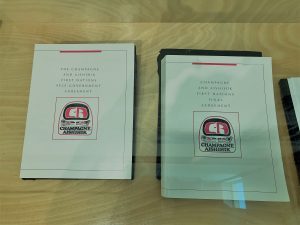
The Kluane First Nations in Burwash Landing and a picture of the final signed agreement at the Da Ku Cultural Centre, Yukon. PC: David Lee and Emmanuel Adoasi-Ahyiah
What I did take the most from learning about the Indigenous communities of South-West Yukon at the Da Ku (a place of home) Cultural Centre and Burwash Landing was that despite having made the bold and rightful decision to become a self-governing nation, they are continually greatly affected by the socioecological pressures on their native lands. The overexploitation of wildlife resources because of the construction of the Alaska Highway in 1942 led to the creation of the National Park and Reserve leading to the ejection of an entire group of people who relied on the reserve for economic and socio-cultural sustenance. This meant that they had to change their traditional livelihood and indigeneity to cope with these changes. Their culture was lost, and I can only imagine how alienated it was for them to see the home of their ancestors and yet forbidden to live there. As a person several miles away from my ancestral home, I could not help but feel disheartened. Moving from the reserve, they had to turn to ‘fishing’ and other forms of livelihood, hence, a major reorganization of their cultural practices. Even though they are allowed into the reserve now, there is what may seem a lack of interest and/or fear that lingers amongst the people. For years, they have depended on the largest lake in the region, Kluane Lake, to support their livelihoods. Therefore, I was discontent to learn that the lake had reduced by about 2 meters in the past two years. A decline we came to learn was a side effect of the receding Kaskawulsh Glacier that was initially feeding the Slims river valley that was subsequently feeding the Kluane Lake. The local people were not able to organize boat races within the past two years as a result. It is important to note at this point that Kluane like many other areas is changing. All these could not help but make me think about how well equipped the Indigenous People are, in terms of systems and services compared to bigger cities like Vancouver. Another thing that raised a red flag for me was learning that the small community of Destruction Bay only had one nurse practitioner. This was no different from back home in rural areas in developing countries. This made me question how adequate and accessible the medical system in Kluane and its surrounding communities is, especially when the primary receivers are people of colour.
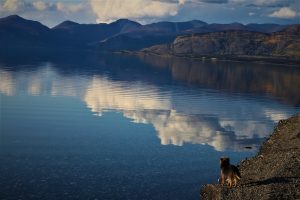
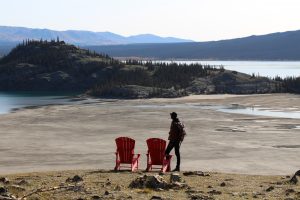
The receding Kluane Lake, views from the Kluane Lake Research Station and Soldier’s Summit, Yukon. PC: Emmanuel Adoasi-Ahyiah and David Lee
The topic of inequality seemed to be a bit of a recurring theme in my time at Yukon. Our time through the Soldier’s Summit, which was designed to acknowledge the work of the American soldiers (both white and people of colour) who constructed the Alaskan Highway in 1942, was rather short. Descriptive notes along the highway telling us stories of what had occurred gave us a general history of the place. What stood out to me the most and had a profound effect on my emotions at the time, was learning about the treatment of the African-American soldiers within the military. They faced serious discrimination through segregation from their white counterparts even though they were also risking their lives and serving their country. It moved me to tears when I thought about the fact that as a black man amongst predominantly white peers, I would have been alienated and/or treated less for doing the same things like them on that very same spot and many other areas, just several decades ago. This is not to mean that the system is perfect since many things are still designed to work against people of colour. I have always wondered what made people think that by the virtue of their colour they were superior to all others. Why alienate some people from others although they were performing the same task. If this injustice and inequality existed within the American troops that were working on the Alaskan Highway, it was not very surprising that the Indigenous People were segregated and unfairly mistreated. It cannot be overemphasized, however, that injustice, inequality and racial discrimination in whatever form must be erased from every socio-ecological system.

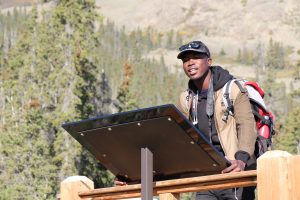
Emmanuel Adoasi-Ahyiah reading one of the plaques at the summit of the Soldiers Summit about the history of the Alaskan highway construction and its associated inequality and discrimination towards the First Nations People, Yukon. PC: David Lee
One of the nicer and simpler moments of our expedition was our hike up Sheep Mountain. This was in many ways a very accurate experience of the pristine natural beauty of Yukon. Coming from a forestry background it was interesting to see how different the tree line looked as the altitude increased along the trail. Many different species in the ecosystem that I was not used to seeing in and around British Columbia, with the most fascinating being the Dall sheep, who were perfectly adapted to thriving in such elevated conditions. It reminded me of how resilient life is, and the ability to triumph almost anywhere it pleases. It is truly a remarkable sight to see in a lifetime and I had a great time learning about how little changes in soil moisture could influence floral, grass and shrub distribution on the land.
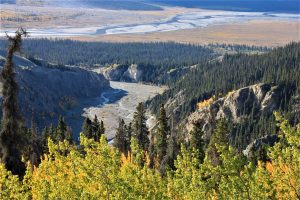
The forest, the Slims River, the mountains and all else seen and unseen all in one picture. This is one of the sights to behold on the Sheep Creek Trail in Yukon. PC: Emmanuel Adoasi-Ahyiah
I learned the most about Yukon’s biodiversity on the Spruce Beetle Trail. As its name suggests, it comes from the Spruce beetle, a notorious pest that attacks the Spruce trees. I was most keen on the effects of the reintroduction of the very prominent wood bison. There seem to be several problems from different sides arising from having them back in the region. The thriving bison populations in Yukon is an overall conservation success story, but such large and dominant land mammals roaming around in healthy populations can come with certain complex changes that the local people have to learn to live with. They have proven to change the ecosystem, raising questions on how to handle human-wildlife conflicts as well as understanding how their niche and diet web overlaps with other species such as moose and caribou. Overall, I believe this leaves room to acknowledge how important it is to communicate and consult First Nations and local communities, who are the primary stakeholders and custodians of the land, on serious decisions on conservation such as species reintroduction.
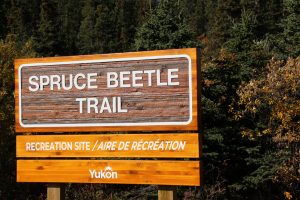
The Spruce beetle trail signpost at the beginning of the trail, Yukon. PC: David Lee
Worth mentioning about conservation efforts in Yukon was our meeting with Bruce Bennet, the coordinator of the Yukon Conservation Data Centre. He was exceptionally inspiring with his love for botany and studying interesting plant species in the Northern Territories, South-West Yukon in particular. He pointed out the importance of scientific research and taxonomy in more remote areas because we learn invaluable things and make discoveries of new species, like the two endangered moss species found by chance. I equally agree with him and feel that it is extremely important in exploring and navigating how to best mitigate climate change and its effects on biodiversity in the sub-Arctic and Arctic, which are some of the most vulnerable regions on our planet.
Silver City was a great piece of history to learn about this part of Canada. I was a bit surprised that gold was found this far up North in the early 1900s, but more so that people seriously still went in search of it despite it drying up rather quickly in parts of the lower South like BC, Washington State, and Oregon. It was quite a revelation, albeit an expected one that the gold never led to the development of the area. It is a common theme to witness precious resources doing nothing to benefit local miners and communities in the developing world. It was quite haunting to see that it had not been inhabited since the 1940s.
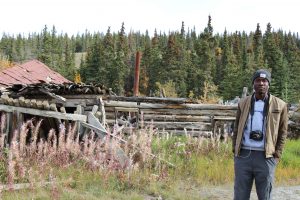
The deserted Silver City, which was once a flourishing and livable town with the discovery of gold, Yukon. PC: David Lee
SO WHAT WAS LEARNED ON THIS EDUCATIONAL ADVENTURE?…..
Before the field trip, we were provided with the course outline and requirements for the successful completion of the course. A glance at the outline and requirements gave me a sense of accomplishment even before the course. A very well detailed outline and only three assignments followed by a reflection piece. Little did I know that it was going to be one of the most challenging yet educating and enlightening exercises I had ever done in my academic life and that I would have to go beyond my lines and comfort zone to achieve them. The assignments were done in groups of three, which encouraged knowledge sharing, teamwork and divergent ways of thinking about and addressing socio-ecological issues in a landscape. The three assignments were my biggest moment of learning on this course. The purpose of the assignments was to explore Complex Adaptive System (CAS) theories, and how they contribute to the understanding and interpretation of socio-ecological systems, to sustainably manage human interactions with the landscape in the Kluane region. To achieve this, we completed the three assignments consecutively by building upon each completed one.
For the first assignment, we were tasked to develop a conceptual model of the Kluane landscape. The assignment helped me to improve my understanding of ecosystems and social systems on the Kluane landscape by identifying key components (processes and actors) of the landscape. This was the first step towards building our model. We organized the key actors and processes identified in a model structure by appreciating connections and possible interactions that exist between them. We then identified from the proposed model key features that could drive the landscape responses to changes and disturbances. Our biggest challenge was including all the identified actors and processes into our model. We named our model “The Model of Cascading Effect” against the backdrop that all actors and processes in a/an (eco) system or landscape are interconnected. Our model showed that a change or effect on one or other factors and processes in a landscape has the potential to influence another, which could lead to a continuous chain of influencing each other. What stood out to me at the end of this assignment is how often managers of resources manage only what they feel are important and relevant forgoing all else in the landscape. Most often than not, resources are managed without acknowledging the people (Indigenous or not) who depend on them and have varying uses for them, which is not surprising given the science over the past decades. However, our model and that of my other colleagues illustrated that people (especially Indigenous) were the key component that interacted with other components in the model. The lesson learned is that to be able to manage complex systems we must learn to use our science to manage systems towards self-regulating and sustaining themselves, an act carried out by the Indigenous people for 1000s of years, and not managing them in a ‘command and control’ way according to our science.
In the second assignment, we were tasked to expand on our analysis of the Kluane region to include scales of space and time and to develop an understanding and appreciation of the challenges that could arise in the landscape when managing across multiple hierarchical scales. This assignment emphasized the importance of scales (temporal, spatial and hierarchical) in understanding and managing the Kluane landscape. This was no easy feat to accomplish. We were challenged in our ability to accurately assign scales to all the actors and processes in the Kluane landscape. To achieve this, we grouped our actors and processes into two groups: ecological and environmental. We then assigned scales to each of the actors and processes and then compared the scale interactions that were occurring between them. We used the heat map approach to present our idea of which scales overlap and which ones do not amongst all the actors and processes identified. At the end of the assignment, I understood the importance of scale and cross-scale interactions in the analysis of a complex system. From the heat map, we were able to identify the parts of the Kluane landscape where there was a mismatch in social and ecological scales of time, space and function known as “scale-misfits” based on our model. We analyzed and proposed solutions that could potentially be used to overcome the scale-misfits and gaps identified. It is, however, important to note that almost all the scale-misfits identified were “wicked problems” which had no clear-cut solutions to addressing them.
The final assignment allowed us to develop and evaluate management prescriptions and strategies for the Kluane landscape based on our knowledge from the previous assignments and the exploration of the impacts of uncertainties that could arise in the Kluane socioecological system. We expanded our findings by evaluating a set of management constraints and opportunities for the Kluane landscape over a period of 50years. To achieve this, we first began by developing a conceptual model for our goals for the Kluane landscape. Based on our goals, we listed out critical factors, trends and uncertainties that possibly influence our goals positively or negatives. We then proceeded to map out the factors, trends, and uncertainties on a scale of impact and the certainty of occurrence in the landscape. This gave us a broader scope into the most influential factors and their level of impact and uncertainty in the landscape. We, therefore, postulated three scenarios out of a lot about how the Kluane region could change over the next 50years. Based on the scenarios, we postulated solutions to managing differently in the present, in ways based on our goals to address these changes and prevent their occurrence or if not have an adaption strategy to them. What I learned most from the exercise was the fact that each of the groups came up with different scenarios and management strategies to address these scenarios in the present having the future in mind. It got me thinking even to this day …“How different would the earth be if resource managers did not take an interest in just the resource in the landscape but the landscape as a whole managing it today for tomorrow?”
Talking of thoughts, there are so many questions that have been on my mind since embarking on this trip. Some may just be “out of the blue” but then what if all these were answerable. What if we had all the answers all these while as a species but never gave thought to or paid attention. What if we went back and learned from the people of the land just like the popular saying “When you go to Rome, you do what the Romans do” (Unknown). How different would things be if we viewed them as connected pieces forming a whole and not in isolation? Yes! They may be complex, but is not that what everything is? From human systems to ecosystems, and from the lands to the landscapes. This is but a reflection of thoughts, thoughts that we must all begin to reflect on in hope of changing things in the future.
In conclusion, the field course was one of the most thought-provoking, educational and insightful trips in my academic life. I am thankful to Prof. Parrot for organizing such a course trip and leading us to one of the best moments of learning. To the amazing group of students with whom I had the pleasure to spend the period of learning with I am grateful for the opportunity to exchange thoughts and ideas and cherish every moment we spent together as a group. To the staff of the Kluane Research Station, I am appreciative of your warmth in welcoming us and ensuring that we had one of the best times in the station. To Go Global and Mastercard Foundation, UBC I say a very big thank you for your support in making this trip a reality. Finally, and most importantly, to the Indigenous People who have stood tall for years on the land of their forefathers and continue to do so, you have our love and support for cherishing and respecting the land in a way no one else can. To summarize my learning experience on the field course recalls one of my favourite quotes by Benjamin Franklin “Tell me and I forget, teach me and I may remember, involve me and I learn.”
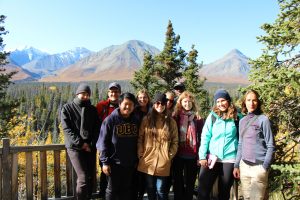
A group picture with Prof. Parrot and other colleagues on the course at the summit of the Spruce Beetle Trail, Yukon. PC: Shawn Taylor
Emmanuel Adoasi-Ahyiah
MSc Forestry
Ghana